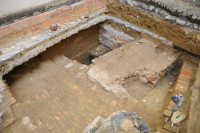Archaeological Excavation in Pannonhalma
During spring, within the framework of the multi-disciplinary research-programme entitled “Kings, Saints, Monasteries”, a planned excavation took place in the Archabbey’s area. The excavation was headed by Ágoston Takács, a doctoral candidate of Eötvös Loránd University, Department of Archaeological Sciences.
After the crypt of Tihany and the monastery-courtyard of Bakonybél, supported by HUN-REN (formerly: Eötvös Loránd Research Network) and coordinated by the Research Centre for the Humanities, the third item of the realised project was Pannonhalma. The aims of the research included the hopeful identification of the remains of the former royal mansion, and the examination of the Basilica’s western facade, searching for a possible tower-foundation. The preliminary geophysical survey of archaeological purpose was conducted by the experts of the National Archaeological Institute, Hungarian National Museum.
The scattered bones excavated from the debris-filled, mixed soil in the courtyard to the north and east of the Basilica showed that formerly a large cemetery was located there, where five disturbed graves were found. The cemetery was disturbed as early as the Ottoman period. Evidence of this is the massive, one-and-a-half-metre wide wall, most probably reinforced with a timber framework, which divided the narrow courtyard. The inner fortress-wall presumably defending the church was cut off by an underground vaulted corridor towards the west. The charred ground surface found on the outer side of the wall may disclose one of the conflagrations of the Ottoman period. On the eastern side of the sanctuary, the former 11th-12th-century sanctuary-foundation’s traces could not be separated.
The possible south-western counterpart of the formerly found large foundation-wall to the north-west of the church that could have been explained as the tower-foundation did not come to light because in this region the area is much more deeply disturbed than in the northern side. Thus, only traces of construction from the Baroque period and later ages were identified, foundations were not found.
